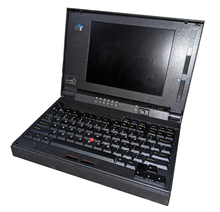A request that this article title be changed to ThinkPad 350 is under discussion . Please do not move this article until the discussion is closed. |
This article needs additional citations for verification .(April 2024) |
This article contains instructions, advice, or how-to content .(April 2024) |
 | |
 An IBM ThinkPad 350 sitting open. | |
| Manufacturer | |
|---|---|
| Type | Notebook Computer |
| Release date | June 1993 |
| Lifespan | 1993-1994 |
| Introductory price | Starting at US$2,099(equivalent to $4,569 in 2024) |
| Discontinued | September 1994 |
| Media | Floppy Disk |
| Operating system | |
| CPU |
|
| Memory | 4-20 MB |
| Storage | 125 - 250 MB internal hard drive |
| Display | Types
|
| Graphics | Chips & Tech. - 65530 |
| Input |
|
| Connectivity |
|
| Weight | Up to 5.7lb |
| Predecessor | IBM ThinkPad 300 |
| Successor | IBM ThinkPad 360 |
| Website | www |
The IBM Thinkpad 350 series was a notebook computer series introduced in 1993 by IBM as part of their Thinkpad laptop series. It was the successor to the IBM ThinkPad 300. [1] With only 2 models ever made in the series, it was succeeded in 1994 by the IBM Thinkpad 360 series.
